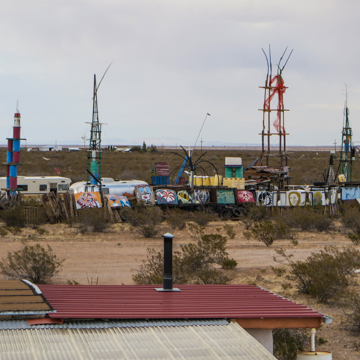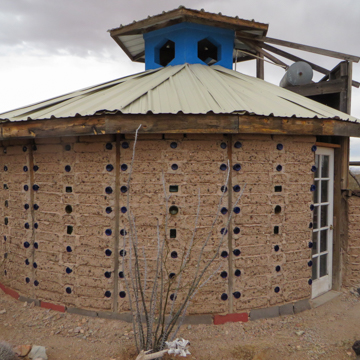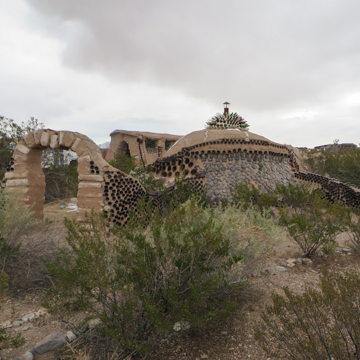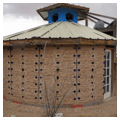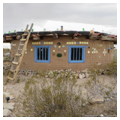The City of the Sun Foundation, located on the edge of the desert town of Columbus at the very bottom of New Mexico, is one of the oldest New Age intentional communities in the state.
The community belongs to a utopian tradition in the United States that draws from multiple metaphysical sources, including Swedenborgianism, Theosophy, Spiritualism, and Transcendentalism, as well as nineteenth-century idealistic communities like New Harmony and Brook Farm, which are now referred to as “intentional communities,” meaning a group of people who come to together to live and practice a shared set of beliefs. In the 1960s and 1970s, thousands of such communities sprang up across the country, including the Lama Foundation (1967), New Buffalo (1967), and The Hog Farm (1968) in northern New Mexico. The desire for freedom that inspired these communities meant they frequently lacked organizational and physical structure and this caused many to fail, yet the City of the Sun has endured.
It was founded in 1972 by the Reverend Wayne Taylor and his wife Grace Taylor to prepare for the Age of Aquarius, a transformational astrological age that became a subject of intense interest and speculation in the late 1960s. Following the guidance of a disembodied entity called Master Hilarion (or the Apostle Paul), they intended to provide a haven during the tumultuous events expected to accompany the transition to the Age of Aquarius with a design that was “lowered from the heavenly realms by the spiritual Hierarchy of the earth planet.”
The Taylors arrived in Columbus in 1968 and began working to establish a community on a 159-acre parcel that they owned and later donated to City of the Sun. The southern quarter of the parcel was developed first; divided into three long sections, it is separated by two streets running in an east-west direction. The north section was set aside for trailers, the middle section for apartments, and the south section for individual homes. A common area, containing a “Vortex of Light,” bisects the city along a north-south axis, while a community building, erected in 1974–1975, is located on its east end. The Vortex of Light was viewed as a source of tremendous spiritual energy, visible to those with psychic abilities, and the area around it was developed into a Healing Center in 1984. A pyramid intended to balance and manipulate energy was erected to its immediate east.
The first issues of The Golden Dawn, the community’s newsletter, offered guidelines for future construction. One article noted that “adobe-type homes and the SUN seem to belong together.” Though The Golden Dawn approved of architecture in Santa Fe and Albuquerque, the City of the Sun should, the newsletter argued, aspire to evoke “the City Beautiful.” Another included plans and elevations for Pueblo-Spanish Revival Style apartment complexes with two-bedroom units, as well as a proposal for smaller, studio-style apartments. Collective housing, however, has remained an exception at City of the Sun, where detached individual residences predominate.
In 1986, the community built an adobe brickyard with the goal of increasing self-sufficiency, and in 1988 it began “The West End Project”— a group of quarter-acre lots for experimental homes that employ sustainable building practices. The northern three-quarters of the City of the Sun remain “off-the-grid” and include some of its most unusual structures.
Ted Specker, who joined the City of the Sun in 1989–1990, designed innovative buildings and sculptures of earth combined with such salvaged materials as bottles and tires. Some are partially underground and one large structure has an excavated plaza surrounded by subterranean rooms. Specker described his work, with its undulating contours, natural materials, and engagement with the earth, as “feminine architecture,” though the forms and materials also have clear analogies with Paolo Soleri’s Cosanti in Paradise Valley, Arizona, and Mike Reynolds’ Earthships outside of Taos.
“Papercrete,” a combination of paper and concrete introduced by Mike McCain in the late 1990s, is also an important building material. Supplemented by salvaged materials, it has been used to create buildings that mediate between sculpture and architecture. Perhaps the most striking work at City of the Sun is a compound on the north side, enclosed by a tall fence decorated with painted panels and containing four towers, 30 to 40 feet tall, constructed from salvaged metal. Like the rest of the City of the Sun, this points to a collective community ethos that prioritizes individual expression.
Visits can be arranged by contacting the City of the Sun Foundation.
References
"City of the Sun Foundation Articles of Incorporation." City of the Sun Foundation. Accessed February 17, 2015. http://cosf.unternet.net/aoi/.
"City of the Sun Foundation Bylaws." City of the Sun Foundation. Accessed February 17, 2015. http://cosf.unternet.net/bylaws/.
“City of the Sun Foundation, Inc.” Fellowship for Intentional Community. Accessed February 17, 2015. http://www.ic.org/directory/city-of-the-sun-foundation-inc/
Fairfield, Richard. The Modern Utopian: Alternative Communities of the 60s and 70s. With contributions by Timothy Miller, Alan Watts, Nick Tosches, and the Underground Press Syndicate. Port Townsend, WA: Process Media, 2010.
Farmington [NM] Daily Times.“‘Fidobe’ Houses no Pulp Fiction.” July 25, 1999.
Hayden, Dolores. Seven American Utopias: The Architecture of Communitarian Socialism, 1790–1975.Cambridge: MIT Press, 1976.
Homman, Faun. Letter to the editor. Deming [NM] Headlight, March 25, 1976.
Lewis, James R. The Encyclopedia of Cults, Sects, and New Religions. Amherst, NY: Prometheus Books, 2002.
Miller, Timothy. “New Mexico’s New Communal Settlers.” New Mexico Historical Review 87, no. 1 (Winter 2012): 69-74.
Roswell [NM] Daily Record.“Pair Experiment with Solar Houses. February 15, 1998.
Sutton, Robert P. Modern American Communities: A Dictionary. Westport, CT: Greenwood Press, 2005.
Taylor, Wayne H. Pillars of Light. Penang, Malaysia, 1965.
The Golden Dawn. Originally published by the City of the Sun Foundation. American Religions. Series 1, Part 2, Reel 99. Woodbridge, CT: Gale Cengage Learning/Primary Source Media.














